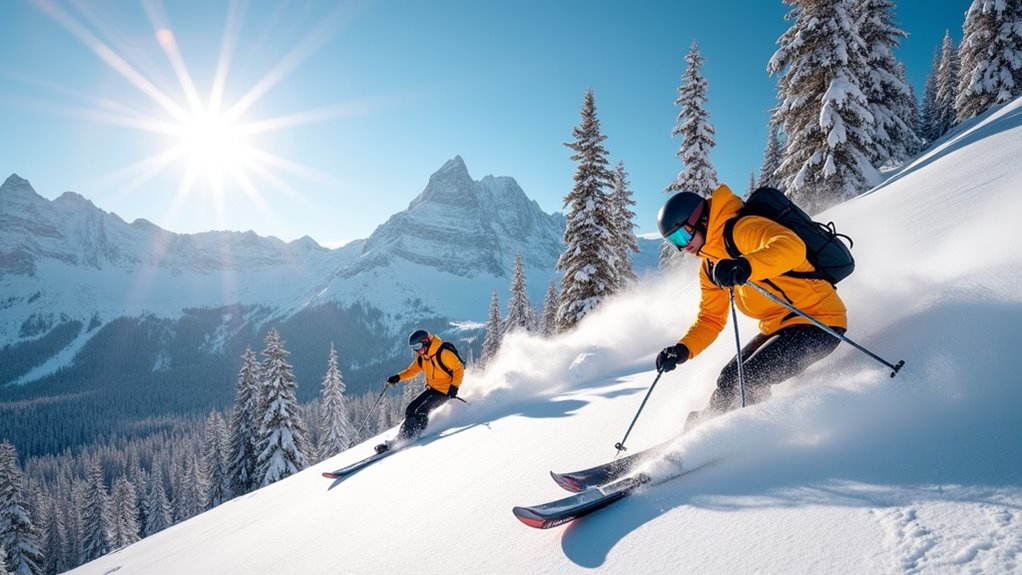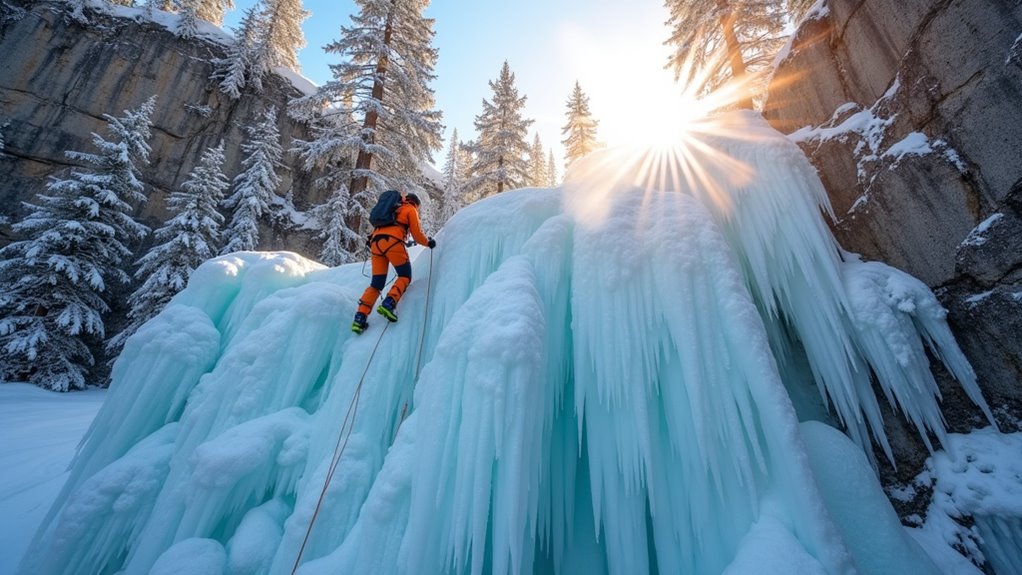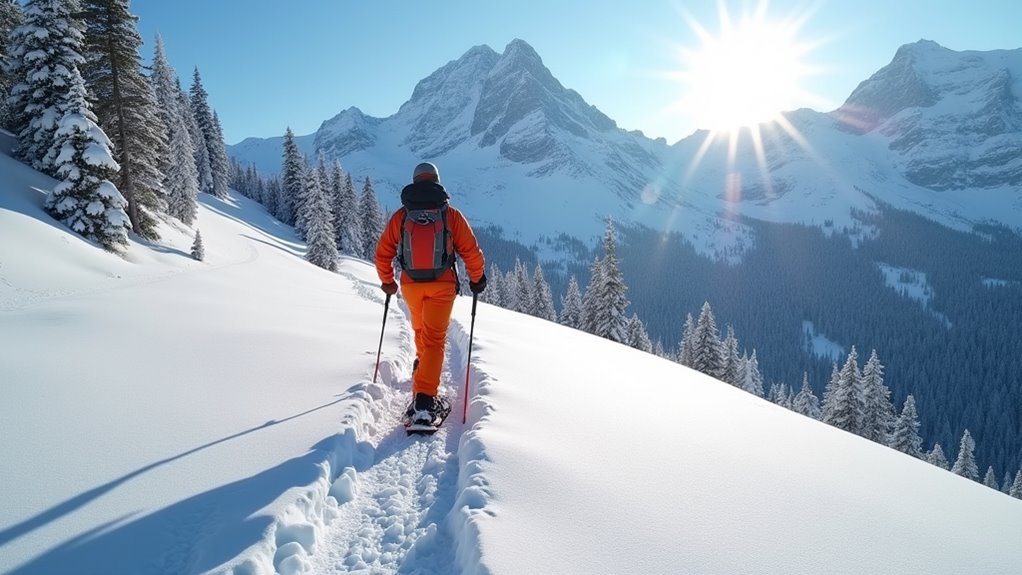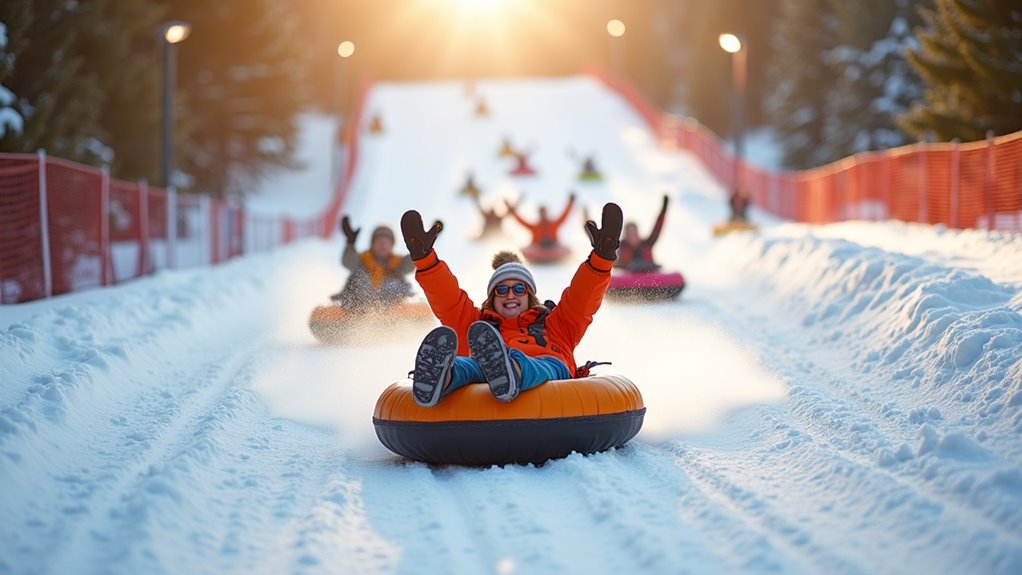Physical Address
304 North Cardinal St.
Dorchester Center, MA 02124
Physical Address
304 North Cardinal St.
Dorchester Center, MA 02124

From epic powder runs to frozen waterfall climbs, discover ten thrilling snow adventures that will transform your winter into an unforgettable season.
You’ve probably heard that winter’s the perfect time to hibernate indoors, but that theory couldn’t be more wrong. Winter transforms landscapes into playgrounds brimming with affordable adventures that’ll connect you with local cultures and traditions. From budget-friendly snowshoeing trails to community ice fishing spots, cold-weather activities offer authentic experiences you simply can’t find during warmer months. The key lies in knowing which adventures deliver the most value for your money and cultural insight.

Where else can you experience the pure rush of carving through fresh powder while surrounded by breathtaking mountain vistas? Downhill skiing and snowboarding offer unmatched winter thrills, but smart planning saves money while maximizing enjoyment.
Consider smaller, local mountains over famous resorts—you’ll find cheaper lift tickets, shorter lines, and authentic mountain culture. Rent equipment initially to test preferences before investing thousands. Many resorts offer beginner packages combining lessons, rentals, and lift access at discounted rates.
Skip the crowded mega-resorts and discover local mountains where authentic culture meets budget-friendly prices and shorter lift lines.
Pack your own lunch instead of buying overpriced lodge food. Stay in nearby towns rather than slope-side hotels for significant savings. Visit mid-week when possible for reduced crowds and lower prices.
Join the mountain community by chatting with locals, learning snow conditions, and discovering hidden runs that aren’t on trail maps.
For those seeking even more extreme winter adventures, glacier climbing provides the ultimate challenge on America’s most pristine icy peaks.
Why settle for crowded slopes when cross-country skiing offers solitude, affordability, and full-body fitness rolled into one winter activity? You’ll discover pristine wilderness trails while burning more calories than downhill skiing. Unlike expensive resort passes, cross-country skiing costs minimal fees at most locations.
Start with classic technique on groomed trails before attempting skate skiing. Rent equipment initially—boots, skis, and poles cost under $40 daily. Many Nordic centers offer lessons that’ll teach proper kick-and-glide motion within hours.
Essential cross-country skiing benefits:
For overnight adventures on backcountry trails, consider bringing a four-person tent like the Pegasus Tent to accommodate your skiing group comfortably.
You’ll find cross-country skiing transforms winter from endurance test into adventure.

How does racing across snow-covered landscapes at 60 mph sound for your next winter adventure? Snowmobiling delivers unmatched winter thrills while connecting you to local snow culture.
You’ll find rental shops in most snow-belt towns offering half-day packages from $150-250, including gear and brief training. Many areas provide guided tours through backcountry trails, forests, and frozen lakes—perfect for beginners wanting cultural insights from local guides.
Budget wisely by splitting rental costs with friends or choosing weekday rates. Pack your own snacks and thermos to avoid expensive trail stops. Essential gear includes insulated boots, goggles, and layered clothing.
Always check trail conditions and weather forecasts beforehand. Most rental shops offer group discounts, making this adventure surprisingly affordable when shared among four people. If you find yourself loving the sport, consider whether renting or buying a snowmobile makes more financial sense for your long-term winter adventures.
Snowshoeing transforms winter hiking into an accessible adventure that connects you directly with snow-covered wilderness at a fraction of snowmobiling’s cost. You’ll need basic snowshoes ($50-150), waterproof boots, and layered clothing to start exploring immediately.
You’ll burn 400-1000 calories per hour while experiencing winter’s silence and beauty. Most state parks offer rentals and guided tours for beginners. For those seeking multi-day winter adventures, consider exploring renowned hiking routes like Scotland’s West Highland Way, which offers spectacular snow-covered landscapes during winter months.

While snowshoeing offers gentle winter exploration, ice climbing catapults you into vertical frozen worlds where waterfalls become crystalline highways to adventure. You’ll need specialized gear: ice axes, crampons, and helmet ($300-500 rental).
Start at indoor climbing gyms or beginner-friendly frozen waterfalls with certified guides ($150-200/day).
Popular destinations include Colorado’s Ouray Ice Park, New Hampshire’s Cathedral Ledge, and Canada’s Banff. Many communities offer affordable group lessons and gear libraries.
You’ll develop technical skills while experiencing winter’s raw power firsthand.
Budget-smart climbers join local mountaineering clubs for shared transportation and group discounts. Pack high-energy snacks and thermos drinks – you’ll burn calories fast in cold conditions.
Always check ice conditions and weather forecasts. This sport transforms frozen landscapes into accessible vertical playgrounds.
Before heading out, ensure your pack includes essential first aid supplies to handle any injuries that might occur on the ice.
Where else can you experience the pure joy of gliding across pristine snow while eight enthusiastic huskies power your sled through winter wonderlands? Dog sledding connects you with centuries-old Inuit traditions while delivering an adrenaline rush that’s surprisingly affordable.
Most operators offer half-day experiences starting around $150, making this adventure accessible without breaking your budget. You’ll learn traditional mushing commands like “gee” (right) and “haw” (left) while understanding the deep bond between mushers and their teams.
For overnight sledding expeditions in remote areas, consider investing in a quality air mattress to ensure comfortable rest between days of arctic adventure.

If dog sledding gets your heart racing, winter hiking offers a quieter but equally rewarding way to explore snowy landscapes on your own terms. You’ll need microspikes or snowshoes depending on terrain depth, plus insulated boots and layered clothing. Start with shorter trails near your home to test gear without expensive travel costs.
Choose popular routes where other hikers create packed trails—it’s easier on your legs and safer for navigation. Bring extra food since cold burns more calories, and pack a thermos with hot drinks. Local hiking groups often organize winter outings, giving you cultural insights about seasonal traditions while splitting gas costs.
Winter hiking connects you to landscapes locals cherish during quiet months, offering authentic experiences beyond tourist seasons while keeping adventure budgets manageable. Keeping your shelter dry during camping becomes crucial when temperatures drop and moisture can freeze, creating uncomfortable and potentially dangerous conditions.
Thousands of frozen lakes transform into fishing grounds each winter, offering you access to species that stay active beneath the ice when warm-weather anglers have stored their gear. You’ll find walleye, northern pike, and perch feeding actively in the cold depths, making winter your secret fishing season.
Essential ice fishing gear won’t break your budget. You’ll need a basic ice auger, simple jigging rods, and warm shelter. Many communities rent equipment, letting you test this tradition before investing.
For those seeking more active winter pursuits, consider combining your ice fishing trip with hiking adventures through snow-covered trails that lead to remote fishing spots.

When gravity becomes your engine, snow tubing delivers pure winter thrills without requiring years of skill development or expensive equipment. You’ll find commercial tubing hills across winter destinations, offering groomed runs and lift services for around $20-40 per session. Many resorts rent tubes on-site, eliminating transport hassles.
Choose hills with varied difficulty levels – gentle slopes for families, steeper runs for adrenaline seekers. Most facilities provide safety briefings and enforce weight limits, ensuring secure experiences. You’ll master basic techniques quickly: lean back, keep feet up, and steer gently using your body weight.
Pack waterproof gloves and wear layers you can move in freely. Many tubing parks feature warming huts and snack bars, creating perfect spots for breaks between runs. Consider bringing great gifts for your fellow campers to share the winter adventure experience together.
Why settle for crowded resort slopes when untouched powder awaits beyond the boundaries? Backcountry skiing offers unparalleled freedom and pristine conditions, but it demands proper preparation and respect for mountain hazards.
You’ll need avalanche education, beacon/probe/shovel gear, and touring skis with climbing skins. Start with guided tours to learn route-finding and snowpack assessment. Local mountain clubs often offer affordable courses and group trips.
Budget-wise, backcountry access costs less than lift tickets long-term, though initial gear investment runs higher. Many ski towns have gear swaps and rental programs. Planning your family camping adventures alongside winter sports creates memorable multi-season outdoor experiences.
You’ve got nine incredible snow adventures waiting, but here’s the secret: start small and build your winter confidence. Like a snowflake that begins as a single ice crystal and grows into something magnificent, your first snowshoeing expedition or local sledding hill visit can spark a lifelong passion. According to outdoor recreation surveys, 73% of winter enthusiasts started with free or low-cost activities before investing in expensive gear. Bundle up and take that first step outside.